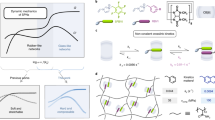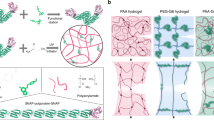Abstract
Rubbers exhibit enormous extensibility up to several hundred per cent, compared with a few per cent for ordinary solids, and have the ability to recover their original shape and dimensions on release of stress1,2. Rubber elasticity is a property of macromolecules that are either covalently cross-linked1,2 or connected in a network by physical associations such as small glassy or crystalline domains3,4,5, ionic aggregates6 or multiple hydrogen bonds7,8,9,10,11,12,13,14,15,16. Covalent cross-links or strong physical associations prevent flow and creep. Here we design and synthesize molecules that associate together to form both chains and cross-links via hydrogen bonds. The system shows recoverable extensibility up to several hundred per cent and little creep under load. In striking contrast to conventional cross-linked or thermoreversible rubbers made of macromolecules, these systems, when broken or cut, can be simply repaired by bringing together fractured surfaces to self-heal at room temperature. Repaired samples recuperate their enormous extensibility. The process of breaking and healing can be repeated many times. These materials can be easily processed, re-used and recycled. Their unique self-repairing properties, the simplicity of their synthesis, their availability from renewable resources and the low cost of raw ingredients (fatty acids and urea) bode well for future applications.
This is a preview of subscription content, access via your institution
Access options
Subscribe to this journal
Receive 51 print issues and online access
$199.00 per year
only $3.90 per issue
Buy this article
- Purchase on SpringerLink
- Instant access to full article PDF
Prices may be subject to local taxes which are calculated during checkout




Similar content being viewed by others
References
Tabor, D. Gases, Liquids and Solids and Other States of Matter 3rd edn, Ch. 13 (Cambridge Univ. Press, Cambridge, UK, 1991)
Rubinstein, M. & Colby, R. H. Polymer Physics (Oxford Univ. Press, Oxford, UK, 2003)
Holden, G., Kricheldorf, H. R. & Quirk, R. P. Thermoplastic Elastomers 3rd edn (Hanser, Munich, 2004)
Fakirov, S. Handbook of Condensation Thermoplastic Elastomers (Wiley-VCH, Weinheim, 2005)
Handlin, D. L., Trenor, S. & Wright, K. in Macromolecular Engineering (eds Matyjaszewski, K., Gnanou, Y. & Leibler, L.) Vol. 4 2001–2031 (Wiley-VCH, Weinheim, 2007)
Mac Knight, W. J. & Lundberg, R. D. in Thermoplastic Elastomers (eds Holden, G., Kricheldorf, H. R. & Quirk, R. P.) 3rd edn 261–283 (Hanser, Munich, 2004)
Stadler, R. & de Lucca Freitas, L. Thermoplastic elastomers by hydrogen bonding. 1. Rheological properties of modified polybutadiene. Colloid Polym. Sci. 264, 773–778 (1986)
Stadler, R. Thermoplastic elastomers via supramolecular self-assembling in random copolymers. Kautschuk Gummi Kunststoffe 46, 619–628 (1993)
Sijbesma, R. P. et al. Reversible polymers formed from self-complementary monomers using quadruple hydrogen bonding. Science 278, 1601–1604 (1997)
Lange, R. F. M., Van Gurp, M. & Meijer, E. W. Hydrogen-bonded supramolecular networks. J. Polym. Sci. A. 37, 3657–3670 (1999)
Chino, K. & Ashiura, M. Themoreversible cross-linking rubber using supramolecular hydrogen-bonding networks. Macromolecules 34, 9201–9204 (2001)
Bosman, A. W., Brunsveld, L., Folmer, B. J. B., Sijbesma, R. P. & Meijer, E. W. Supramolecular polymers: from scientific curiosity to technological reality. Macromol. Symp. 201, 143–145 (2003)
Colombani, O. et al. Attempt toward 1D cross-linked thermoplastic elastomers: structure and mechanical properties of a new system. Macromolecules 38, 1752–1759 (2005)
Peng, C. C. & Abetz, V. A simple pathway towards modification of polybutadiene: a new approach to thermoreversible cross-linking rubber comprising supramolecular hydrogen-bonding networks. Macromolecules 38, 5575–5580 (2005)
Elkins, C. L., Park, T., McKee, M. G. & Long, T. E. Synthesis and characterization of poly(2-ethylhexyl methacrylate) copolymers containing pendant, self-complementary multiple-hydrogen-bonding sites. J. Polym. Sci. A 43, 4618–4631 (2005)
Kautz, H., van Beek, D. J. M., Sijbesma, R. P. & Meijer, E. W. Cooperative end-to-end and lateral hydrogen-bonding motifs in supramolecular thermoplastic elastomers. Macromolecules 39, 4265–4267 (2006)
Lehn, J. M. Supramolecular Chemistry: Concepts and Perspectives (VCH, Weinheim, 1995)
Fouquey, C., Lehn, J.-M. & Levelut, A. M. Molecular recognition directed self-assembly of supramolecular liquid crystalline polymers from complementary chiral components. Adv. Mater. 2, 254–257 (1990)
Ligthart, G. B. W. L., Scherman, O. A., Sijbesma, R. P. & Meijer, E. W. in Macromolecular Engineering (eds Matyjaszewski, K., Gnanou, Y. & Leibler, L.) Vol. 1, Ch. 9 351–399 (Wiley-VCH, Weinheim, 2007)
Kolomiets, E., Buhler, E., Candau, S. J. & Lehn, J. M. Structure and properties of supramolecular polymers generated from heterocomplementary monomers linked through sextuple hydrogen-bonding arrays. Macromolecules 39, 1173–1181 (2006)
Bouteiller, L. Assembly via hydrogen bonds of low molar mass compounds into supramolecular polymers. Adv. Polym. Sci. 207, 79–112 (2007)
St., Pourcain, C. B. & Griffin, A. C. Thermoreversible supramolecular networks with polymeric properties. Macromolecules 28, 4116–4121 (1995)
Ault, W. C. in Kirk-Othmer Encyclopedia of Chemical Technology 2nd edn, Vol. 8 845–849 (Interscience, New York, 1964)
Muller, M. et al. Junctions dynamics in telechelic hydrogen bonded polyisobutelene networks. Macromolecules 29, 2577–2583 (1996)
Cates, M. E. Reptation of living polymers: dynamics of entangled polymers in the presence of reversible chain-scission reactions. Macromolecules 20, 2289–2296 (1987)
Drye, T. J. & Cates, M. E. Living networks: the role of cross-links in entangled surfactant solutions. J. Chem. Phys. 96, 1367–1375 (1992)
Rubinstein, M. & Semenov, A. N. Dynamics of entangled solutions of associating polymers. Macromolecules 34, 1058–1068 (2001)
Warner, M. & Terentjev, E. M. Nematic elastomers—a new state of matter? Prog. Polym. Sci. 21, 853–891 (1996)
Cloitre, M., Borrega, R. & Leibler, L. Rheological aging and rejuvenation in microgel pastes. Phys. Rev. Lett. 85, 4819–4822 (2000)
Cipelletti, L., Manley, S., Ball, R. C. & Weitz, D. A. Universal aging features in the restructuring of fractal colloidal gels. Phys. Rev. Lett. 84, 2275–2278 (2000)
Acknowledgements
We thank P.-G. de Gennes for interest and support. We thank M. Cloître, J.-M. Lehn, K. Matyjaszewski and S. Stupp for discussions. We also thank M. Milléquant and S. Girault for their help with chromatography and X-ray scattering experiments, respectively. We are indebted to Arkema and in particular to M. Hidalgo for enlarging our views on some industrial aspects of this project. CNRS, ESPCI, Arkema and DGA are thanked for financial support.
Author information
Authors and Affiliations
Corresponding author
Supplementary information
Supplementary Figures
The file contains Supplementary Figures 1-6 with Legends. (PDF 230 kb)
Supplementary Movie 1
The file contains Supplementary Movie 1 demonstrating self healing of supramolecular rubber. Small movie showing the tensile test of a mended sample (compound B). Originally the sample was cut and the cut parts were brought together and healed at room temperature. At the beginning of the movie, the scar is not visible. It appears during the stretching and finally a fracture propagates and the sample breaks. We inked a rectangular area so that the deformation can be appreciated. Please note the elastic recovery after the sample is broken. (MP4 3780 kb)
Supplementary Movie 2
The file contains Supplementary Movie 2 demonstrating extensibility of supramolecular rubber. Small movie showing the extensibility of the supramolecular rubber plasticized by water. (MPG 335 kb)
Rights and permissions
About this article
Cite this article
Cordier, P., Tournilhac, F., Soulié-Ziakovic, C. et al. Self-healing and thermoreversible rubber from supramolecular assembly. Nature 451, 977–980 (2008). https://doi.org/10.1038/nature06669
Received:
Accepted:
Issue Date:
DOI: https://doi.org/10.1038/nature06669



